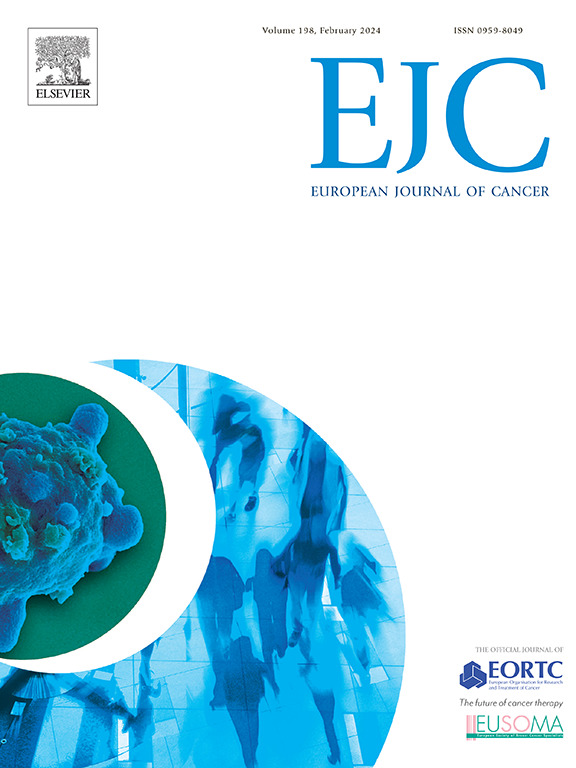Prediabetes persistence or remission and subsequent risk of gallbladder cancer: A nationwide cohort study
IF 7.6
1区 医学
Q1 ONCOLOGY
引用次数: 0
Abstract
Background & aims
Hyperglycemia is associated with an increased risk of gallbladder cancer (GBC), potentially by inhibiting gallbladder motility and inducing prolonged cholestasis. Although intermediate hyperglycemia (or prediabetes) is highly reversible, evidence is lacking about whether prediabetes persistence or remission is associated with an altered GBC risk.
Methods
This nationwide cohort study included 6058,662 adults without diabetes or cancer who underwent national health examinations twice in 2-year intervals between 2009 (S1) and 2011 (S2) and were followed-up until 2018. Prediabetes was defined as a fasting plasma glucose level of 100–125 mg/dL. We categorized changes in prediabetes status into: stable normoglycemia, new-onset prediabetes, prediabetes remission, and persistent prediabetes groups. GBC risk was estimated using Cox proportional hazards models, after adjusting for potential confounders.
Results
During 38.6 million person-years (median 6.4 years) of follow-up, 1349 new GBC cases were identified. Among 1409,474 individuals with prediabetes at S1, 768,515 achieved prediabetes remission at S2, outnumbering the 640,959 individuals with persistent prediabetes. GBC incidence probability was consistently higher among individuals with persistent prediabetes than in individuals with stable normoglycemia or prediabetes remission (all log-rank P < 0.01). Compared with stable normoglycemia, persistent prediabetes was associated with increased GBC risk (adjusted hazard ratio [aHR], 95 % CI: 1.21, 1.04 to 1.41). The aHRs of GBC were 1.14 (95 % CI, 0.99 to 1.33) and 1.03 (95 % CI, 0.88 to 1.21) for new-onset prediabetes and prediabetes remission, respectively.
Conclusions
Individuals with persistent prediabetes had a significantly increased risk of GBC, whereas those with prediabetes remission had no increased risk. Achieving prediabetes remission has a significant potential to reduce the risk of GBC.
糖尿病前期持续或缓解与随后的胆囊癌风险:一项全国性队列研究。
背景和目的:高血糖与胆囊癌(GBC)风险增加有关,可能是通过抑制胆囊蠕动和诱导长期胆汁淤积。虽然中度高血糖(或糖尿病前期)是高度可逆的,但关于糖尿病前期的持续或缓解是否与胆囊癌风险的改变有关,目前还缺乏证据:这项全国范围的队列研究纳入了 6058662 名未患糖尿病或癌症的成年人,他们在 2009 年(S1)和 2011 年(S2)之间每隔两年接受了两次国民健康检查,并随访至 2018 年。糖尿病前期的定义是空腹血浆葡萄糖水平为 100-125 毫克/分升。我们将糖尿病前期状态的变化分为:血糖稳定正常组、新发糖尿病前期组、糖尿病前期缓解组和糖尿病前期持续组。在对潜在的混杂因素进行调整后,使用 Cox 比例危险模型估算 GBC 风险:在 3,860 万人年(中位数 6.4 年)的随访期间,发现了 1349 例新的 GBC 病例。在 1409,474 名 S1 期糖尿病前期患者中,768,515 人在 S2 期糖尿病前期得到缓解,人数超过了 640,959 名糖尿病前期患者。持续性糖尿病前期患者的 GBC 发生率始终高于血糖稳定正常或糖尿病前期缓解的患者(均为对数秩和 P 结论):糖尿病前期持续存在者患 GBC 的风险明显增加,而糖尿病前期缓解者患 GBC 的风险没有增加。糖尿病前期缓解有很大可能降低 GBC 风险。
本文章由计算机程序翻译,如有差异,请以英文原文为准。
求助全文
约1分钟内获得全文
求助全文
来源期刊

European Journal of Cancer
医学-肿瘤学
CiteScore
11.50
自引率
4.80%
发文量
953
审稿时长
23 days
期刊介绍:
The European Journal of Cancer (EJC) serves as a comprehensive platform integrating preclinical, digital, translational, and clinical research across the spectrum of cancer. From epidemiology, carcinogenesis, and biology to groundbreaking innovations in cancer treatment and patient care, the journal covers a wide array of topics. We publish original research, reviews, previews, editorial comments, and correspondence, fostering dialogue and advancement in the fight against cancer. Join us in our mission to drive progress and improve outcomes in cancer research and patient care.
 求助内容:
求助内容: 应助结果提醒方式:
应助结果提醒方式:


